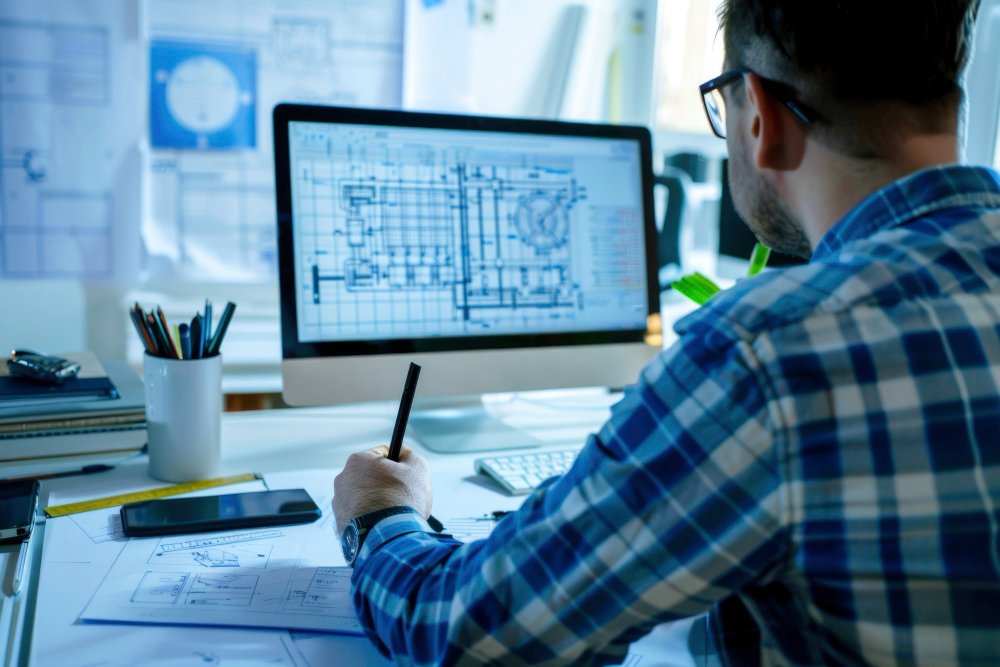CAD drafting is a modern technology used to create technical designs. It is replacing traditional methods in the engineering and manufacturing industries. This modern work involves technical design knowledge. This guide explores CAD drafting, its applications, different types of software, and the future of the field. Let’s dive in!
What is CAD Drafting?
CAD Drafting is a process of making technical drawings with the help of computer software. It includes lines, dimensions, and symbols. Engineers use software to create 2D and 3D drawings, models, and plans for tangible items. The software helps in corrections, duplicating elements, and storing large projects.

CAD is used across many industries, including architecture, engineering, manufacturing, and product design. Professionals design floor plans, machine parts, electrical layouts, and more.
Historical Context and Evolution of CAD Drafting
Before computers, all technical drawings were made by hand. Engineers and architects used pencils, rulers, and paper to draw plans. This manual method was slow and prone to errors. Redrawing or editing a design took a lot of time. Large teams of draftsmen were needed for big projects. Accuracy and consistency were hard to maintain across many pages.
In the 1960s, the first Computer-Aided Design (CAD) systems were developed. These early systems were basic and expensive, used mainly by the aerospace and automotive industries. In the 1980s, personal computers and software like AutoCAD made CAD drafting more accessible. Over time, CAD tools evolved to include 3D modeling, simulations, cloud storage, and real-time collaboration. Today, CAD is essential in almost every design and engineering field.
Types of CAD Drafting
CAD drafting has several types based on industry needs and design requirements. Each type focuses on specific standards, tools, and outcomes. Understanding these types helps professionals choose the right method for their projects. Let’s have a look at boosting your project with our AutoCAD drafting services!
➤ 2D Drafting
It involves creating flat drawings with height and width but no depth. These drawings include floor plans, elevations, and sections. They are mostly used in construction and engineering. This type of drafting is essential for creating blueprints. It includes dimensions, annotations, and symbols that help in construction and manufacturing processes. So, get our Professional CAD Drafting services today!
➤ 3D Modelling
3D modeling creates objects with height, width, and depth. This is useful for visualizing designs and testing how parts fit together. It is often used in mechanical engineering, architecture, and animation. 3D models can be rotated, rendered, and analyzed for stress, weight, or motion. This helps in better design decisions and improves final product quality.
➤ Architectural Drafting
Architectural drafting is used to design buildings and structures. It includes floor plans, elevations, roof plans, and construction details. Architects use it to show how a building will look and how it will be built. This type of drafting follows building codes and standards.
➤ Mechanical Drafting
Mechanical drafting is for machines, engines, tools, and mechanical systems. It includes detailed parts drawings, assembly instructions, and manufacturing specifications. This type of drafting helps engineers and manufacturers understand how parts will fit, move, or interact. It reduces the chance of errors in production.
➤ Civil Drafting
Civil drafting focuses on infrastructure projects like roads, bridges, water systems, and land development. It includes topographic maps, site plans, and grading designs. Civil drafters work with engineers and city planners to make sure construction follows codes and aligns with the environment.
➤ Drafting for 3D Printing
Drafting for 3D printing involves creating digital models that can be turned into physical objects. It uses 3D CAD software to design items layer by layer. These models must be accurate, closed (watertight), and exportable to 3D printer formats like STL. This is used in product design, prototyping, healthcare, and more. So, ready for reliable CAD Drafting? Schedule a consultation today!
➤ Electrical Drafting
Electrical drafting deals with wiring diagrams, circuit layouts, and control systems. It shows how electrical systems are connected and where each component is placed. Electrical drafters work with engineers to create safe and reliable electrical designs for buildings, machines, and power systems.
Uses of Computer-Aided Drafting
Computer-Aided Drafting (CAD) is widely used across various industries. Its uses are given in depth below. Just have a look!
- Design buildings, floor plans, and architectural layouts
- Create road maps, bridges, and infrastructure plans
- Draft machine parts, tools, and mechanical equipment
- Draw electrical circuits and wiring diagrams
- Plan interior layouts and space arrangements
- Model automotive components and vehicle frames
- Build aircraft parts and aerospace structures
- Prepare 3D models for printing and prototyping
- Map site layouts for urban development
- Outline marine vessels and ship components
- Sketch clothing designs and fashion items
- Arrange PCB layouts for electronic devices
- Set landscape designs for gardens and parks
- Construct furniture plans for production
What is a CAD Drafter?
A CAD drafter is a person who uses computer software to make technical drawings. These drawings show how to build things like houses, machines, or electrical systems. The drafter follows the designer’s ideas and makes them clear and detailed on a screen.
CAD design and drafting work are used in many fields, like construction, engineering, and product design. Their drawings help others build things correctly. They need to be careful and accurate so that the final product works well and is safe to use
Advantages and Drawbacks of CAD Drafting
CAD Drafting has many benefits and drawbacks. Just explore!

Advantages of CAD Drafting
CAD drafting is fast and accurate. It helps in creating clean and precise designs with fewer errors. You can make changes easily without redrawing everything. This saves time and effort. It also improves teamwork. Many people can work on the same design and share files easily. CAD makes 3D models possible, which helps people understand how a final product will look and work.

Drawbacks of CAD Drafting
CAD software can be expensive. It needs powerful computers and regular updates. Learning CAD takes time and training, which may not be easy for everyone.
What is the Future of CAD Drafting?
CAD drafting will integrate more AI and Machine Learning. These technologies improve automation, error detection, and design optimization. Cloud-based CAD provides real-time collaboration and remote access to projects.
Virtual Reality (VR) and Augmented Reality (AR) will improve 3D visualization and design review. BIM (Building Information Modeling) integration will increase, improving data management. CAD software will become more efficient and user-friendly.
Conclusion
This article covers in-depth information for CAD drafting. It is a vital skill in modern design and engineering. It combines technical knowledge with powerful software to create accurate drawings and models. As technology advances, CAD drafting will become more automated and collaborative.
CAD drafting will continue to grow in all industries. It makes work faster, easier, and more accurate. With new features, it will become even more powerful and creative. People who learn CAD drafting will have great career opportunities in architecture, engineering, design, and more.
Frequently Asked Questions(FAQ's)
Q1. What software is used for CAD drafting?
Common tools include AutoCAD, Revit, SolidWorks, Fusion 360, and SketchUp.
Is CAD drafting hard to learn?
It takes time and practice, but many online courses and tutorials make it easier.
Q3. Can I use CAD for 3D printing?
Yes. CAD software can create 3D models for printing.
Q4. What industries use CAD drafting?
Architecture, mechanical, civil, electrical, interior design, and product development.
Q5. Do I need a degree to become a CAD drafter?
Not always. Some positions accept certificates or diplomas with strong CAD skills.

